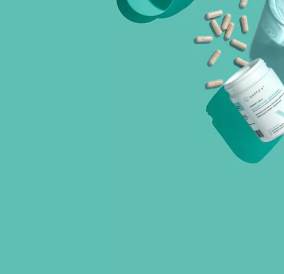- Fact Checked
- May 16, 2022
- 12 min read
Table of Contents
No one enjoys getting a urinary tract infection (UTI). UTIs common symptoms, including pain while urinating to having the hit the restroom every couple of minutes, send most people rushing to get antibiotic therapy as soon as they experience an onset of symptoms.
Unfortunately, for many people, urinary tract symptoms return after receiving initial treatment. Experts estimate about 20% of women will experience a recurrent infection after treatment is complete.1 Unfortunately, living with a long-term UTI or bladder infection isn’t just annoying, it’s dangerous! Persistent UTIs can result in complicated infections like kidney infections, which can cause permanent kidney damage over time. That’s why it’s important to create an effective treatment strategy with your healthcare provider, so you can deal with a chronic infection before it causes long-term health problems.
If you just can’t shake a UTI, you might hear your infection referred to as a “chronic infection” or “recurring.” Understanding the difference between these terms can help you identify why you keep getting UTIs and understand how to deal with them once and for all.
What’s the Difference Between Recurring and Chronic UTIs?
A recurrent UTI (sometimes called a recurrent bladder infection) is defined as two infections occurring within 6 months or three or more infections within 12 months. For example, let’s say you just finished antibiotic therapy for a UTI and were officially cleared of the disease-causing bacteria, such as E. coli. But only a few weeks or months later, you feel those awful urinary tract symptoms coming on once again! In this case, you would have what doctors call a recurrent UTI. When you have a recurrent UTI, your treatment is effective, but you develop another, new UTI after treatment for your first one.
Chronic UTIs are different. With a chronic UTI, treatment doesn’t completely kill the bacterial communities causing your infection. Your symptoms may have gone away, and you might even think your bacterial infection has been dealt with. Unfortunately, once you stop treatment, your acute symptoms return because the bacteria are still in your urinary tract.
To recap: With recurrent UTIs, new bacteria cause reinfection, signaling a lifestyle factor or physical abnormality may be causing frequent infections. With chronic UTIs, the medical treatment you received was not effective at clearing the system of the pathogen.
Different Types Of Chronic UTIs
There are several different classifications of chronic UTIs depending on which parts of the body are affected, and how severely.
- Interstitial cystitis (also called recurrent or chronic cystitis) is a bladder disease that interferes with the ability to urinate. This can cause pain and pressure in the bladder and an urgent need to urinate even when the bladder only contains small amounts of urine.
- Chronic prostatitis is a condition that affects the prostate. and can cause pain in the lower abdomen, difficulty urinating, and blood in urine. Since women don’t have a prostate, this kind of chronic UTI only affects men.
- Recurrent pyelonephritis is a type of chronic UTI that occurs when bacteria repeatedly infect one or both of your kidneys. This can cause fever, chills, nausea, vomiting, and pain below the ribs in the back or side.
- An asymptomatic UTI is a UTI that causes no symptoms. This is the most dangerous type of UTI, since it’s hard to detect but can cause severe damage over time.
How Common are Recurring and Chronic UTIs?
The urinary tract infection is one of the most common conditions in the U.S., with adult women experiencing them more often than men due to risk factors including their anatomy. It is estimated that 8 million women in the United States will experience a UTI this year.2 One in five women with a history of UTIs will experience a second UTI, and of those, one in three will experience a third. If a woman has three UTIs a year, their risk for having a persistent bladder infection is 80%.3
Photo by Matteo Vistocco on Unsplash
What Causes a UTI in the First Place?
If you’re wondering what causes UTIs in women, you’re not alone. Many women feel in the dark about how they got a UTI in the first place, making it extremely difficult to prevent themselves from getting another.
In short, this common infection occurs when bacteria enters the urinary tract via the urethra and starts to grow. Bacterial growth can start at the urethra and move its way up the urinary tract quickly, infecting the urethra, bladder, ureters, and kidneys. Infections in women are more common because their urethra is shorter than the urethra in men, so bacteria doesn’t have to travel as far to cause an infection.
E. coli is the common cause of UTIs, accounting for nearly 90% of all infections, but there are many different bacteria can cause an infection to occur, including klebsiella pneumoniae, staphylococcus, enterococcus, and even gardnerella vaginalis (yes, the bacteria that causes bacterial vaginosis (BV) may cause chronic UTIs, too!).4
There are many different factors that can increase your risk of UTIs, including:
- Sexual Activity. One of the most common areas on your body for bacteria to thrive is, you guessed it—the anus. When you have sex, even vaginal sex, you increase your risk that bacteria from your anus will be transferred to your urethra. Using the restroom after having sex can help to flush bacteria from your urinary tract, but it’s not a foolproof method to avoiding UTIs completely. It’s important to mention that you can get a UTI whether you’re with one sexual partner or several. A UTI is not a sexually transmitted infection, and it can develop even in children or people who aren’t sexually active.
- Hormonal Changes. Pregnancy, menopause, and even contraceptives like birth control pills or rings can cause your body’s natural hormone balance to fluctuate, which can increase your risk for a UTI. That’s why pregnant people and post-menopausal women are more likely to develop UTIs.
- Diabetes. Diabetes can affect the function of the urinary tract, so some diabetic patients experience an underactive or overactive bladder, which can cause UTIs. Diabetic patients may also experience diminished sensation in their urinary tract, which can make it difficult to know when their bladder is full (this is also why people with spinal cord injuries commonly develop UTIs). A failure to empty the bladder when full can cause UTIs to develop, making people with diabetes more likely to have UTIs.
- Weakened Immune System. If your immune system is weakened, you may be more susceptible to recurrent UTIs.
- Urinary Tract Abnormalities. Various problems can occur with the urinary tract, including bladder stones, birth defects in the urinary tract, or a urinary tract obstruction.
What Causes Recurring UTIs?
There’s good and bad news about a recurring urinary tract infection. We’ll start with the good news—since each recurrent UTI is a new infection, they’re as easy to treat as if you’d only had one infection. These infections aren’t caused by antibiotic-resistant bacteria, and your body should respond well to treatment.
The bad news is this type of recurring urinary infection is usually caused as a result of either an anatomic abnormality or a lifestyle situation that increases your risk of developing an acute infection.
Some people are just born with very short urethras or another anatomic abnormality that can make it easy for them to become infected. If this is the case, there’s little that can be done to reduce the risk of developing further UTIs.
Lifestyle habits are more easy to change and can significantly reduce the risk of UTIs for most people. Taking a few preventative measures can reduce your risk of developing a UTI. Stick to this list of dos and don’ts to minimize your risk factors:
- DO use the restroom after having sexual intercourse to flush harmful bacteria out of the urethra.
- DO always wipe from front to back after using the restroom. This avoids transferring bacteria from your anus to your urethra accidentally.
- DO nourish your body with a healthy diet composed of nutrient-dense foods. This can help maintain your body’s natural bacteria and support the growth of good, infection-fighting bacteria.
- DO drink lots of water each day, especially if you think you’re developing a UTI. Drinking a lot of water will make you have to use the restroom frequently, which will flush out bad bacteria.
- DO always wash your hands before inserting a tampon or menstrual cup to avoid introducing bacteria to your urethra.
- DON’T douche. Douching can clear your vagina and urinary tract of the good bacteria that produce natural defenses against UTIs.
- DON’T wear wet swimsuits or underwear longer than absolutely necessary. Damp swimsuits and underwear create a great environment for bacteria to thrive.
- DON’T use vaginal creams, cleansers, or other feminine products. Many infections in women are caused by overcleaning their genital area. Your vagina is equipped to clean itself; you don’t need to do anything more than shower regularly to keep your genital area healthy. Using vaginal creams and cleansers can introduce bacteria and kill off good bacteria accidentally.
Photo by Clay Banks on Unsplash
The Importance of Pre- and Post-Treatment UTI Testing for Recurrent UTIs
Unfortunately, at the moment there is no one expert opinion on how to manage recurrent UTIs. Unless your healthcare provider tests for a negative urine culture once your antibiotic course is complete, you won’t know if your UTI was completely killed off or not. Testing a single urine specimen before starting treatment, which is standard in most medical practices, won’t help you to know if your current urinary tract symptoms were caused by a new infection or a lingering bacterial growth.
Photo by Drew Hays on Unsplash
What Causes Chronic UTIs?
Chronic UTIs are much more difficult to deal with than recurrent UTIs. That’s because one course of treatment—whether antibiotics or natural treatment options like cranberry products—has already been ineffective at destroying the bacteria. As a result, alternative strategies for treatment of UTIs must be attempted to remove the infection.
There are three main causes of bacterial resistance to treatment:
- The original pathogen was not fully cleared after antibiotic treatment. This could be due to low-dose antibiotics, the patient not completing the full treatment, or having such a severe infection that the antimicrobial properties of the drugs didn’t have a substantial effect.
- The bacteria that causes BV, gardnerella vaginalis, could be present. Active g. vaginalis can reactivate dormant e. Coli, causing a new infection to occur.5
- Biofilm present in the urinary tract was not fully cleared. Biofilm harbors a diverse range of bacteria including e. Coli, and its presence can set off a cycle of chronic UTIs.
Biofilms and Persistent UTIs
Biofilms are kind of a hot topic these days, but some people have never heard of them. Biofilms are a type of slime made up of bacteria. They can form on the walls of the urinary tract, including on the bladder wall or kidney wall, making it difficult for antibiotics to kill the bacteria.
E. Coli, the bacteria responsible for most UTIs, actually sticks physically to the bladder wall through a device called fimbriae, which is a hook-like mechanism that helps it attach to the bladder wall. It works like this:
- First, e. Coli enters the urinary tract via the urethra. Then, once the bacteria colonize, it uses a gene-expression mechanism to open its fimbriae and latch onto the walls of the urinary tract.
- Once the bacteria takes a stronghold of the wall, more e. Coli begin to mount on top of each other, and the biofilm begins to form.
- As the hold becomes stronger, antibiotics become more ineffective at dealing with the biofilm.
Recent studies suggest biofilms may be responsible for chronic UTIs in some women; in fact, women with chronic UTIs are more likely to have biofilms present than women without chronic infections.6
While more research is needed to confirm this link, it could mean that treatment for chronic UTIs needs to go beyond just antibiotics. Additional therapies such as flushing out the urinary tract or using probiotics may help clear biofilms and reduce the incidence of chronic UTIs.
There is no definitive test available to determine if biofilms are present in the bladder. However, if you are experiencing chronic UTIs and your doctor suspects that biofilms may be playing a role, they may order additional tests such as urine culture or bladder ultrasound to help determine if bacteria are present.
Natural Ways To Lower Your Chances of Developing Recurring or Chronic UTIs
One of the best natural ways to prevent recurring or chronic UTIs is to supplement your body with natural treatments like Happy V’s cranberry pills for BV and UTI, D-mannose for UTI, or a probiotic supplement for vaginal health.
While cranberry juice is not effective at clearing the body of UTIs, products containing cranberry extract that have a full blend of polyphenols have shown to inhibit E. Coli gene expression, preventing it from hooking onto the bladder or urinary tract wall and creating biofilm.

D-Mannose + Cranberry
Supports urinary tract health and promotes long-term wellness.
If you have a history of UTIs, trying one of these alternative strategies to preventing their development can help reduce your need for antimicrobial treatment and prevent uncomfortable clinical symptoms that can leave you feeling miserable.
Ultimately, persistent urinary tract conditions should be evaluated by your healthcare provider to ensure your infection gets handled before it causes severe internal damage.
Our experts continually monitor the health and wellness space, and we update our articles when new information becomes available.
- Published on: May 16, 2022
- Last updates: February 08, 2025
Written by Daniella Levy
Edited by Daniella Levy
Medical Reviewed by Dr. Barry Peskin, MD, MBA
Our experts continually monitor the health and wellness space, and we update our articles when new information becomes available.
- Published on: May 16, 2022
- Last updates: February 08, 2025
Written by Daniella Levy
Edited by Daniella Levy
Medical Reviewed by Dr. Barry Peskin, MD, MBA











